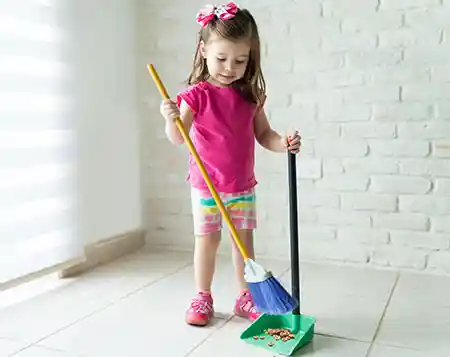Rethinking Classroom Helpers

Rethinking Classroom Helpers:
When Jobs Fit the Child, Not the Chart
Let’s talk about classroom jobs. You know the one: a cheerful chart, a rotating list of helpers, and an eager group of children waiting to see if this is finally their week to be line leader.
There’s a reason this is a staple of many early childhood classrooms. At its best, a system of classroom helpers builds community, supports a sense of stewardship, and helps children develop independence. Children feel involved, responsible, and recognized! It’s a practice that feels both practical and positive; something that belongs in the flow of a well-run day.
Many Hands… Still a Lot of Work
Sometimes the launch of classroom jobs goes smoothly. Other times, it feels bumpy right from the start. Even when things begin on a high note, it’s not uncommon for the system to lose steam a few weeks in. The chart becomes one more thing to manage. The novelty wears off. The same questions pop up again and again. If any of that sounds familiar, you’re not alone.
It’s easy to assume classroom jobs will make the day run more smoothly, that they’ll lighten your already full plate. But in reality, they often become another layer to manage. There’s the setup, the reminders, the negotiations over fairness, and the constant re-teaching if jobs rotate too quickly. When the goal is efficiency, the system can feel like it’s working against you.
What changes things is mindset. When we acknowledge classroom jobs as “one more thing,” but one that we choose intentionally, they become something more than a routine. With a little flexibility, they can grow into opportunities for connection, skill-building, and shared responsibility. The energy we bring to the process is what helps it feel purposeful instead of burdensome. burdensome.
Start with Strengths
Have you had a child who bumps against walls and can’t resist smashing a tower? How about a child who always needs to keep you updated on what everyone else is doing? This part is for you!
What if we started thinking of those behaviors as information? A child who seeks big movement might love stacking chairs or carrying the basket of books to the library. A child who notices every detail might be your “kindness spotter,” someone who helps highlight all the good things classmates are doing.
Jobs don’t have to be generic. They can be personalized, responsive, and strength-based. That doesn’t mean locking a child into one role forever. It just means starting with what comes naturally and building from there.
Let the Rhythm Reveal the Roles
You don’t have to start the year with a fully formed job chart. In fact, some of the most responsive systems grow out of observation and conversation. During the first few weeks of school, you might invite children into the process by saying, “I need your help noticing what parts of our day could use an extra set of hands.” Keep a running list together. Use chart paper, sticky notes, or a clipboard you carry. As the class settles into its rhythm, patterns will emerge. You’ll start to see which jobs are needed most, which children naturally take initiative in certain areas, and what kinds of support make the day feel smoother for everyone.
A class that is particularly inclined to leave chairs willy-nilly around the snack table might inspire a “Chair Pusher.” A particularly prolific class of artists might inspire a “Supply Chief” that keeps you posted when paint, paper, or other materials are running low. These roles might not come with a pre-made chart but emerge from the unique personalities and routines of your group each year. After a week or two, you can work with the children to curate a list of job titles that reflect your group’s real routines, needs, and strengths. Not only does this help children feel ownership, it also ensures that the roles you introduce are rooted in your classroom’s actual flow and culture.
Goal = Connection, Belonging & Growth
If your classroom job system isn’t working the way you hoped, it doesn’t mean you’re doing it wrong. It just means it might be time to pause, watch, and try something new. These systems don’t have to be perfect to be meaningful. They evolve, just like everything else in a classroom.
The best approach I’ve found is to stay curious. What’s working? What’s falling flat? Where are kids already stepping in to help—and how can we name that as valuable? When we lead with flexibility, jobs become more than a checklist. They become part of the way we build relationships, support growth, and create a classroom culture where everyone has a role that fits.
Resources
Classroom Helpers Chart Template: This flexible template is designed to be personalized. Add your own job titles, phrases, and photos, Print, laminate, pop it in a pocket chart, or use with hook and loop sticker dots.

Christine Murray is an Early Childhood Education Specialist with Becker’s Education Team.
As an educator, coach and leader, Christine is inspired by the curiosity, joy and wonder that children so generously model for us. She earned her M.A. in Innovative Early Childhood Education at the University of Colorado Denver and loves collaborating with and supporting others in the field. Grounded in relationships and guided by empathy, Christine is always learning, connecting and creating.
